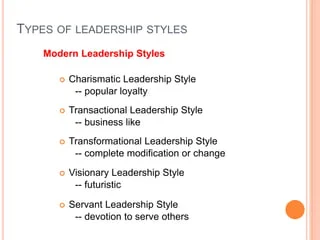

In today’s dynamic and ever-evolving business environment, traditional leadership approaches often fall short of addressing the complexities and demands of modern organizations. As a result, leaders are increasingly embracing contemporary leadership styles that foster innovation, adaptability, and inclusivity. This article delves into some of the most influential modern leadership styles that are shaping the future of business.
1. Transformational Leadership
Transformational leaders inspire and motivate their teams by creating a vision for the future and fostering an environment of continuous improvement. Key characteristics include:
- Visionary Thinking: Transformational leaders articulate a clear and compelling vision that aligns with the organization’s goals. They set a forward-thinking direction, enabling team members to see the bigger picture and understand how their individual contributions fit into the organization’s overall mission.
- Inspirational Motivation: These leaders encourage and motivate team members to exceed their own expectations. By communicating high expectations and expressing confidence in their abilities, transformational leaders inspire their teams to strive for excellence and take on challenges with enthusiasm.
- Individualized Consideration: Recognizing and nurturing each team member’s unique strengths and needs is crucial. Transformational leaders provide personalized support and mentorship, helping individuals develop their skills and reach their full potential. They listen to their team members’ concerns, provide constructive feedback, and celebrate their achievements.
- Intellectual Stimulation: Transformational leaders foster an environment where creativity and innovation are encouraged. They challenge their team members to think critically and solve problems in novel ways. By promoting a culture of continuous learning and curiosity, they drive the organization towards ongoing improvement and adaptation.
- Building Trust and Loyalty: Through their integrity, consistency, and ethical behavior, transformational leaders build trust and loyalty among their team members. They lead by example, demonstrating the values and behaviors they expect from others, which strengthens team cohesion and morale.
- Empowering Others: Transformational leaders empower their team members by delegating authority and encouraging autonomy. They trust their team to make decisions and take ownership of their work, fostering a sense of responsibility and accountability that enhances overall team performance.
2. Servant Leadership
Servant leaders prioritize the well-being and development of their team members, placing a strong emphasis on empathy, listening, and support. Key characteristics include:
- Empathy: Servant leaders understand and address the concerns and needs of their team members. They actively listen, show compassion, and strive to understand the perspectives and experiences of others. This empathy fosters a supportive environment where team members feel valued and respected.
- Stewardship: Taking responsibility for the well-being of the team and organization is central to servant leadership. Servant leaders act as caretakers, ensuring that resources are used responsibly and that the team’s and organization’s long-term health is prioritized. They focus on sustainable practices and ethical decision-making.
- Community Building: Fostering a sense of belonging and collaboration among team members is essential. Servant leaders create a strong sense of community by encouraging teamwork, open communication, and mutual support. They work to build trust and strong relationships within the team, promoting a collaborative and inclusive culture.
- Listening: Effective servant leaders are exceptional listeners. They actively seek input and feedback from their team members, ensuring that everyone’s voice is heard. This approach helps to identify and address issues promptly, fosters innovation, and empowers team members to contribute ideas.
- Commitment to the Growth of People: Servant leaders are dedicated to the personal and professional development of their team members. They provide opportunities for learning, mentoring, and career advancement. By investing in their team’s growth, they help individuals reach their full potential and enhance the overall capabilities of the organization.
- Healing: Servant leaders recognize the importance of addressing and resolving conflicts and emotional wounds within the team. They work to create a safe and supportive environment where team members can express their feelings, recover from setbacks, and build resilience.
- Awareness: Servant leaders maintain a high level of self-awareness and awareness of their surroundings. They understand their own strengths and weaknesses, as well as the dynamics within the team and organization. This awareness helps them to lead with authenticity and make informed decisions.
- Persuasion: Rather than relying on authority or coercion, servant leaders use persuasion and influence to guide their team. They build consensus and encourage buy-in by clearly communicating the rationale behind decisions and involving team members in the decision-making process.
3. Adaptive Leadership
Adaptive leaders are flexible and able to navigate through change and uncertainty. They focus on fostering resilience and encouraging their teams to embrace challenges. Key characteristics include:
- Flexibility: Adaptive leaders adjust strategies and approaches in response to changing circumstances. They are not bound by rigid plans but are open to modifying their methods to address new challenges and opportunities. This flexibility allows them to remain effective and responsive in a fast-paced and unpredictable business landscape.
- Resilience: Building a culture that can withstand and thrive through adversity is a cornerstone of adaptive leadership. Adaptive leaders cultivate resilience by encouraging a positive mindset, promoting mental toughness, and providing the support needed for team members to bounce back from setbacks. They view failures as learning opportunities and inspire their teams to persevere in the face of challenges.
- Continuous Learning: Promoting an environment where learning and growth are integral to the organization’s success is essential for adaptive leaders. They encourage curiosity, innovation, and the ongoing development of skills and knowledge. By fostering a culture of continuous improvement, adaptive leaders ensure that their teams are well-equipped to adapt to new technologies, market conditions, and industry trends.
- Embracing Change: Adaptive leaders not only accept change but also embrace it as a vital part of growth and development. They create an organizational culture that views change positively and prepares for it proactively. This attitude helps teams to be more agile and responsive to external shifts.
- Empowerment: Adaptive leaders empower their team members by giving them the autonomy to make decisions and take initiative. They trust their teams to solve problems creatively and support them in taking calculated risks. This empowerment leads to increased engagement and a stronger sense of ownership among team members.
- Open Communication: Maintaining open and transparent communication is crucial for adaptive leaders. They ensure that information flows freely within the organization, enabling everyone to stay informed and aligned. This openness helps to build trust and facilitates better collaboration and decision-making.
- Diverse Perspectives: Adaptive leaders value diversity of thought and encourage input from a wide range of perspectives. They understand that different viewpoints can lead to more innovative solutions and better problem-solving. By fostering an inclusive environment, they leverage the collective intelligence of their team.
- Anticipation and Preparedness: Adaptive leaders are proactive in anticipating potential challenges and preparing for them. They engage in strategic foresight and scenario planning to identify possible future scenarios and develop contingency plans. This preparedness allows them to navigate uncertainty more effectively.
- Emotional Intelligence: High emotional intelligence is a hallmark of adaptive leaders. They are aware of their own emotions and those of their team members, and they use this awareness to manage relationships judiciously and empathetically. This emotional acumen helps them to lead with compassion and build stronger connections with their team.
4. Authentic Leadership
Authentic leaders are genuine, transparent, and ethical. They build trust and credibility through their consistent actions and values. Key characteristics include:
- Self-Awareness: Authentic leaders have a deep understanding of their strengths, weaknesses, and values. They continuously engage in self-reflection and are aware of how their behavior affects others. This self-awareness enables them to lead with authenticity and make decisions that are aligned with their core values.
- Transparency: Communicating openly and honestly with team members is a hallmark of authentic leadership. Authentic leaders are forthright about their intentions, decisions, and the challenges the organization faces. This transparency builds trust and creates an environment where team members feel secure and valued.
- Integrity: Acting consistently with ethical principles and values is crucial for authentic leaders. They are committed to doing what is right, even when it is difficult. Their integrity fosters trust and respect, setting a positive example for their team and establishing a culture of accountability and ethical behavior.
- Consistency: Authentic leaders are consistent in their actions and decisions. They follow through on their promises and commitments, which builds reliability and dependability. This consistency reinforces trust and strengthens relationships within the team.
- Relational Transparency: Authentic leaders share their thoughts and feelings openly with their team members, creating a sense of psychological safety. They are approachable and encourage open dialogue, which helps to build strong, genuine relationships and fosters a collaborative work environment.
- Balanced Processing: Authentic leaders objectively analyze information and consider multiple perspectives before making decisions. They seek input from their team and value diverse opinions, ensuring that decisions are fair and well-informed. This balanced approach helps to build trust and respect among team members.
- Moral Courage: Authentic leaders possess the courage to stand up for their values and principles, even in the face of opposition. They are willing to make difficult decisions that are in line with their ethical beliefs, demonstrating moral strength and inspiring their team to do the same.
- Empathy and Compassion: Authentic leaders show empathy and compassion towards their team members. They understand and care about their team’s needs, concerns, and aspirations, and they take action to support their well-being and development. This empathetic approach builds strong emotional connections and fosters a supportive work environment.
- Self-Discipline: Authentic leaders practice self-discipline in their personal and professional lives. They are focused, goal-oriented, and committed to continuous self-improvement. This discipline helps them to lead by example and inspires their team to strive for excellence.
- Long-Term Perspective: Authentic leaders focus on long-term success rather than short-term gains. They are committed to sustainable practices and decisions that benefit the organization, its employees, and the broader community over time. This long-term perspective builds a stable and enduring foundation for growth and success.
5. Agile Leadership
Agile leaders thrive in fast-paced, innovative environments. They emphasize collaboration, rapid decision-making, and iterative processes. Key characteristics include:
- Collaboration: Agile leaders encourage teamwork and cross-functional cooperation. They foster a collaborative culture where team members from different departments and disciplines work together towards common goals. This collaboration enhances creativity, problem-solving, and the sharing of diverse perspectives, leading to more innovative and effective solutions.
- Decisiveness: Making timely decisions to capitalize on opportunities is a crucial trait of agile leaders. They assess situations quickly, weigh the available information, and take decisive action. This decisiveness helps the organization to stay ahead of the competition and respond promptly to market changes or emerging trends.
- Iterative Approach: Agile leaders embrace a cycle of continuous improvement and feedback. They implement iterative processes, such as sprints or cycles, to develop, test, and refine ideas and solutions. This approach allows for regular adjustments based on feedback and ensures that the organization remains flexible and responsive to change.
- Adaptability: Agile leaders are highly adaptable, capable of pivoting strategies and approaches as needed. They are comfortable with ambiguity and uncertainty, and they guide their teams through change with confidence and resilience. This adaptability ensures that the organization can navigate disruptions and capitalize on new opportunities.
- Empowerment: Agile leaders empower their team members by giving them the autonomy to make decisions and take ownership of their work. They trust their teams to experiment, take risks, and learn from failures. This empowerment fosters a sense of responsibility and accountability, driving higher levels of engagement and performance.
- Customer-Centricity: Agile leaders maintain a strong focus on customer needs and feedback. They prioritize delivering value to customers through iterative development and continuous improvement. By keeping the customer at the center of decision-making, agile leaders ensure that their teams remain aligned with market demands and customer expectations.
- Transparency: Open and transparent communication is essential for agile leaders. They keep their teams informed about goals, progress, and changes, fostering an environment of trust and mutual understanding. This transparency helps to align efforts and ensure that everyone is working towards the same objectives.
- Experimentation and Innovation: Agile leaders promote a culture of experimentation and innovation. They encourage their teams to test new ideas, iterate on solutions, and learn from both successes and failures. This experimental mindset drives continuous innovation and helps the organization to stay competitive in a rapidly changing market.
- Focus on Results: Agile leaders prioritize outcomes over processes. They set clear, measurable goals and focus on achieving results that drive business value. This results-oriented approach ensures that efforts are aligned with strategic objectives and that the organization can quickly assess the impact of its initiatives.
- Resilience: Agile leaders build resilient teams that can withstand and thrive through challenges. They provide the support and resources needed for their teams to remain focused and motivated, even in the face of setbacks. This resilience enables the organization to maintain momentum and continue progressing towards its goals.
Conclusion
Modern leadership styles are essential for navigating the complexities of today’s business landscape. By embracing transformational, servant, adaptive, authentic, and agile leadership styles, leaders can foster a culture of innovation, resilience, and inclusivity. These contemporary approaches not only enhance organizational performance but also contribute to the personal and professional growth of team members. As businesses continue to evolve, the adoption of modern leadership styles will be crucial in driving sustainable success and achieving long-term goals.





